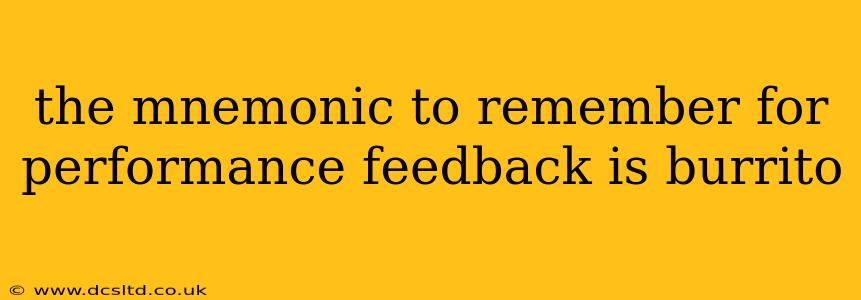Remembering Performance Feedback: The BURRITO Mnemonic
Giving and receiving performance feedback can be a nerve-wracking experience. However, using a simple mnemonic can make the process much smoother and more effective. The BURRITO mnemonic is a fantastic tool to help structure constructive and impactful feedback sessions. Let's break down each letter:
B - Behavior: Focus on specific observable behaviors rather than making general or subjective statements. Instead of saying "You're a poor communicator," say "During the team meeting on Tuesday, your interruption of Sarah's presentation disrupted the flow and prevented others from contributing fully." Concrete examples are key.
U - Understand: Before launching into feedback, take the time to understand the employee's perspective. Ask questions like, "How do you feel you performed in this area?" or "What challenges did you face?" Actively listening demonstrates respect and creates a more open dialogue.
R - Results: Connect the behaviors to tangible results. How did the employee's actions impact the team, project, or company goals? Did their work lead to increased efficiency, improved customer satisfaction, or cost savings? Quantifiable results add weight and clarity to the feedback.
R - Recommendations: This isn't just about pointing out what went wrong; it's about providing concrete recommendations for improvement. Offer specific suggestions and resources to help the employee develop their skills or address the identified issues. Be actionable and supportive.
I - Impact: Explain the impact of the employee's actions (both positive and negative) on the broader team, project, or company. Highlighting the consequences helps the employee understand the significance of their work and the importance of improvement.
T - Timeliness: Ensure feedback is provided timely and regularly. Don't wait until the annual performance review to address important issues. Regular check-ins and ongoing feedback contribute to a more positive and productive work environment. Addressing issues promptly also minimizes the potential for negative impact to accumulate.
O - Ownership: Encourage the employee to take ownership of their performance. Frame the feedback as a collaborative process focused on growth and development, rather than a judgment or criticism. Ask them how they plan to address the identified areas for improvement.
Frequently Asked Questions (FAQ)
What if the employee becomes defensive during the feedback session?
It's crucial to remain calm and empathetic. Acknowledge their feelings, re-emphasize the constructive intent of the feedback, and redirect the conversation back to the specific behaviors and their impact. Active listening and understanding their perspective can help diffuse defensiveness.
How can I make sure my feedback is fair and objective?
Document specific examples of behaviors and results. Use objective metrics whenever possible, and avoid personal opinions or biases. Consider using a structured performance review process to ensure consistency and fairness across all employees.
How often should I use the BURRITO mnemonic when giving performance feedback?
It's a helpful tool for both formal and informal feedback sessions. Consider using it for every performance discussion, whether it's a quick check-in, a mid-year review, or an annual performance evaluation. The more consistently you apply the principles, the more effective your feedback will become.
Can BURRITO be used for self-assessment as well?
Absolutely! Using the BURRITO framework for self-reflection allows employees to assess their own performance, identify areas for growth, and proactively address weaknesses. This approach encourages self-awareness and personal responsibility.
By consistently using the BURRITO mnemonic, you can deliver effective and impactful performance feedback, fostering a culture of continuous improvement and growth within your team. Remember, the goal is to help employees develop and succeed, not just to evaluate past performance.
